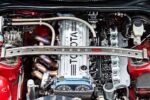Understanding the Mazda L3 Engine
A Brief History
The Mazda L3 engine is part of Mazda’s L family of engines, which gained prominence in the early 2000s. This inline-four engine was designed primarily for compact and mid-size vehicles, offering a balance of performance and fuel efficiency. The L3 engine was utilized in various models, including the Mazda3 and Mazda6, and was known for its relatively lightweight design and advanced engineering features.
Mazda has a long-standing reputation for producing innovative and reliable engines, and the L3 was no exception. It featured a DOHC (Dual Overhead Camshaft) configuration and was equipped with technologies aimed at enhancing performance while maintaining fuel economy. However, as with many automotive engines, the L3 has not been without its issues. Over the years, owners and mechanics have reported a range of problems that can affect the engine’s performance and longevity.
Understanding these issues is crucial for current and prospective owners of vehicles equipped with the L3 engine. While Mazda has made strides in engineering and design, the L3 engine’s problems can lead to significant repair costs and safety concerns if not addressed promptly. This article will delve into the common problems associated with the Mazda L3 engine, providing a straightforward overview of what owners should be aware of to ensure their vehicles remain reliable and safe on the road.
Common Issues with the Mazda L3 Engine
The Mazda L3 engine, while generally praised for its performance and efficiency, is not without its share of problems. Owners have reported various issues that can lead to decreased performance, increased repair costs, and potential safety risks. Understanding these problems is essential for anyone considering purchasing a vehicle equipped with this engine or for current owners looking to maintain their vehicles effectively.
1. Overheating
One of the most common problems associated with the Mazda L3 engine is overheating. This issue can arise from several factors, including:
- Coolant leaks
- Faulty thermostat
- Clogged radiator
- Water pump failure
Overheating can lead to severe engine damage if not addressed promptly. It’s crucial to monitor the engine temperature and check for coolant levels regularly.
2. Oil Consumption
Another prevalent issue is excessive oil consumption. Many L3 engine owners have reported that their engines consume oil at a higher rate than expected. This can be attributed to:
- Worn piston rings
- Valve seal deterioration
- Poor engine design leading to oil leaks
Excessive oil consumption can lead to engine wear and tear, resulting in costly repairs if not managed.
3. Timing Chain Problems
The timing chain in the Mazda L3 engine is known to experience issues, particularly in older models. Common symptoms include:
- Unusual rattling noises from the engine
- Engine misfires
- Check engine light activation
If the timing chain fails, it can lead to catastrophic engine damage, making it imperative to address any signs of trouble immediately.
4. Fuel System Issues
Problems within the fuel system can also plague the L3 engine. These may manifest as:
- Difficulty starting the engine
- Decreased fuel efficiency
- Engine stalling
Common causes include clogged fuel injectors or a failing fuel pump. Regular maintenance can help mitigate these issues.
5. Electrical Problems
Electrical issues can arise in the L3 engine, affecting various components such as:
- Sensors (e.g., oxygen sensors)
- Ignition coils
- Wiring harnesses
These problems can lead to poor engine performance and should be diagnosed and repaired by a professional.
Symptoms and Consequences
To summarize the issues discussed, the following table outlines the symptoms and potential consequences of the problems associated with the Mazda L3 engine:
| Symptoms | Consequences |
|---|---|
| Overheating | Severe engine damage |
| Excessive oil consumption | Increased engine wear and potential failure |
| Rattling noises from the engine | Timing chain failure, leading to catastrophic damage |
| Difficulty starting the engine | Potential fuel system failure |
| Poor engine performance | Increased repair costs and safety risks |




0 Comments